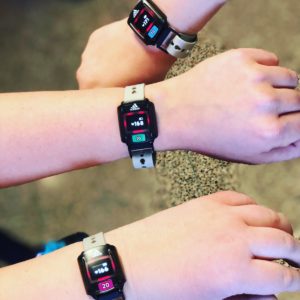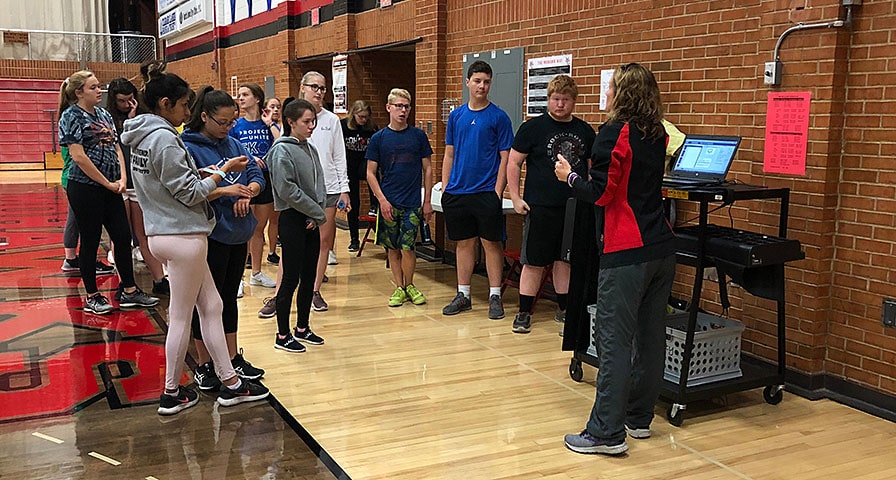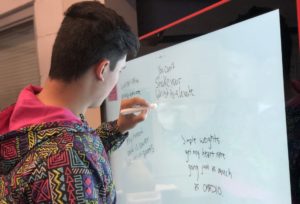Mason City PE Teacher Says Technology Helps Students Stay Engaged, Focused on Seeing What They Are Feeling During Class
Students in Andi Ludwig’s Mason City High School physical education classes use heart rate monitors to reinforce what an effective exercise session feels like.
Beginning during the 2018-19 school year, Ludwig’s students have worn IHT ZONE wrist heart rate monitors while completing workout regimens that range from an exercise circuit to singular activities. Where she’d previously have brief discussions explaining why students felt the way they did during and after a workout, the ZONE monitors and reports students get from the IHT Spirit System have changed Ludwig’s teaching and, more importantly, her students’ understanding.
“In the past, we’d talk about exercise, heart rate, and training zones, and we’d have short lessons about it,” she said. “But now, they are actually experiencing and seeing that happen. There are students surprised that their heart rate was as high as it was, but then they’d check it manually and realize it is beating faster. It’s just a huge level of awareness, and instead of just talking about it, they can actually see what’s going on.”
Learning Which Activities Boost Heart Rate Levels
Keeping each student engaged in PE class has traditionally been a challenge, but Ludwig has had no such problems after introducing the technology.
“That’s where the monitors come in,” she said. “Whereas before, students came into class, they worked out and left. Now there is evidence of their workout. That’s leading to better engagement.”
Students also take an active interest in what’s happening at different points of each class session. The ZONE shows them their heart rate in real-time and the post-session report they receive via email reinforces the feeling. And Ludwig asks questions during the session.
“When we first started wearing them, I’d ask questions about what they were feeling and what they were doing, and most students would still respond, ‘well, I don’t know,’” Ludwig said. “But as they start to pay attention to what’s happening, I can ask and they say, ‘oh, that’s when I was doing jumping jacks or the running circuit.’’
Students have data that shows them how their heart responds during different activities:
- Fitness circuit;
- Body-weight strength training;
- Yoga or Pilates
Ludwig used past personal experience to make sure she introduced the heart rate monitors properly and helped students set expectations.
“I’ve been in schools where teachers just throw heart rate monitors on students, and that’s not fair to them,” she said. “We’ve implemented the monitors where it’s actually a real-life application, things like yoga and fitness, so they can have a good experience with it.”
Using Session Reports in Conjunction with Classroom Software Skills
Mason City Technology Integration Coach Kassie Drey, herself a former PE teacher, wants students to become proficient with the software they use each day, tools such as Google Classroom. To encourage students to learn the different elements of the classroom software, Drey and Ludwig, who were profiled on a local radio talk show “Mohawks on the Move,” want students to use the information they get in their heart rate summary emails to create presentations in programs such as Google Slides.
“We want them to be able to reflect,” Drey said. “We want them to take screenshots of their reports and use them as an overlay. They will be creating reports that show how they’ve improved using a pre-semester graph and a post-semester graph.”
The long-term goal, Drey said, is to get students familiar enough with what an effective, heart-health enhancing workout looks like. At that point, students will not only reflect on just-completed sessions, they can also create their own lessons, post them on Google Classroom and then reflect on those, further personalizing their PE experience.
“The kids know that exercise is important,” Ludwig said. “The heart rate monitors bring the true data to life. Students may feel, but this allows them to see what they accomplished. Then, with the reports that show how the heart reacted during exercise, we can discuss things like recovery heart rate. Hopefully what we see at the end of the semester is a faster recovery heart rate.”
Focusing on Recovery Heart Rate
Recovery heart rate (RHR) remains one of the most telling indicators of fitness and, in the case of still-developing adolescents, improved fitness. When students see that they’ve lowered their recovery heart rate, they feel a sense of accomplishment, Ludwig said.
“A few of the students have been surprised at how quickly they recover after they’ve been exercising at a higher level of intensity,” she said.
 RHR will be a focal point of Ludwig’s curriculum this year – her second using the ZONE monitors and software. She’ll continue to get students familiar with the heart rate monitors and classroom technology they’ll use outside of PE.
RHR will be a focal point of Ludwig’s curriculum this year – her second using the ZONE monitors and software. She’ll continue to get students familiar with the heart rate monitors and classroom technology they’ll use outside of PE.
“I’m looking forward to a more deliberate implementation,” Ludwig said. “I need to do a better job of educating them in general about the science behind fitness and their heart rate.”
The ultimate goal, Ludwig said, focuses on making sure students find a passion for exercise.
“I just want to keep encouraging and promoting the habit of exercise,” she said. “They have to make time for it away from school, and using what they learn in class through the heart rate monitors and data, they can set good goals and choose what activities they do to meet those goals. It’s about finding things that motivate you because exercise isn’t a one-size-fits-all thing. We just have to keep promoting it to everyone and get them to buy-in.”



